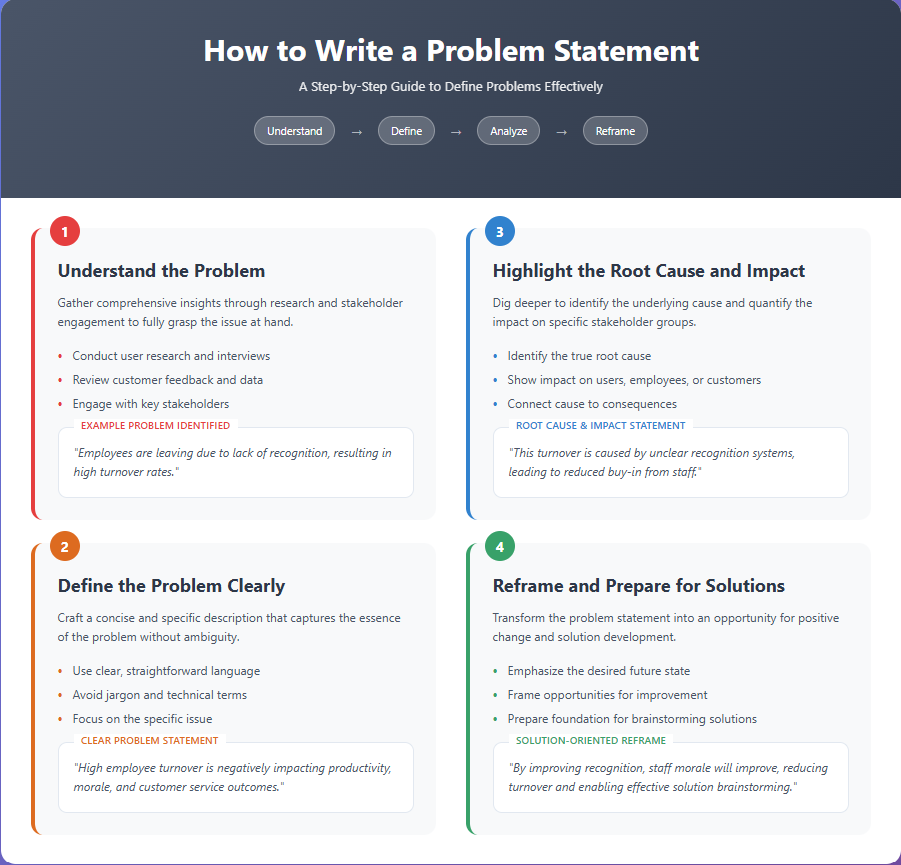Writing Effective Problem Statements
Problem statements are at the heart of research and design work. A well-developed problem statement in research is essential because it ensures that everyone—researchers, stakeholders, and user groups—shares the same understanding of the problem at hand. Writing effective problem statements helps guide user research, improve user experiences (UX), and ultimately leads to effective solutions.
What Are Problem Statements?
- Definition
- A problem statement is a concise description of a specific problem that needs to be solved.
- It explains why the problem exists, how it is negatively impacting user groups, and why it is worth solving.
- Key Purpose
- Provides a clear explanation of the issue that occurs in an environment where the problem affects multiple stakeholders.
- Helps researchers and designers understand the problem before jumping to potential solutions.
- Problem Statement in Research
- In the discovery phase, researchers use problem statements to set direction.
- A statement of the problem aligns teams, highlights the impact of the problem, and ensures focus on solving the right issue.
- That’s where problem statements come into play: they bridge the gap between the current and desired state.
- Problem Statements Don’t Need to Be Complex
- A great problem statement may be just one sentence long.
- The statement makes sense only when it shows how specific groups are affected by the problem.
Expert Dissertation Writing Support
Boost your academic success with Elite Thesis Help. Our professional writers deliver tailored, plagiarism-free dissertations that meet top academic standards. Get expert guidance today and achieve the grades you deserve.
Why Writing Effective Problem Statements Matters
- Clarity for Stakeholders
- By writing effective problem statements, key stakeholders gain a shared understanding of the problem.
- Encourages buy-in and support for future proposed solutions.
- Improves Team Morale
- When everyone works on the same particular issue, morale increases.
- A clear problem statement in research shows that the team is addressing this problem with purpose.
- Reduces Turnover Rates
- Poorly defined problems may frustrate teams, leading to employee turnover and low morale.
- Effective problem statements show teams how to fix the problem and avoid wasted effort.
- Avoids Negative Consequences
- Without a structured statement of the problem, organisations risk:
- Misunderstanding the magnitude of the problem.
- Working on the wrong research problem.
- Proposing possible solutions that fail to solve the problem at hand.
- Without a structured statement of the problem, organisations risk:
- Enables Faster Solutions
- When researchers use problem statements, they can solve problems faster by focusing only on what needs to be solved.
Key Elements of a Strong Problem Statement
- Concise Description
- A clear and concise definition of the problem that highlights the problem impacts on stakeholders.
- Understanding of the Problem
- Includes evidence from interviewing stakeholders, customer feedback, and user research to show why the problem exists.
- Root Cause Identification
- Goes beyond symptoms to identify the root cause of the problem that needs to be solved.
- Current vs Desired State
- Explains the current and desired conditions clearly, showing what needs to be solved.
- Impact of the Problem
- Outlines how the problem affects people, systems, or organisations.
- For instance, rising turnover rates might be linked to morale being negatively impacted.
- Stakeholder Involvement
- Defines who is affected by the problem and who the key stakeholders are in the process.
- Template for Structure
- A template helps researchers work on the statement systematically, ensuring no key detail is missed.
- Focus on Solutions Later
- The problem statement should not be a proposed solution, but a foundation for finding effective solutions later.
How to Write a Problem Statement | Step by Step Guide
- Understand the Problem
- Gather insights from user research, interviewing stakeholders, and reviewing customer feedback.
- Example of a problem: “Employees are leaving due to lack of recognition, resulting in high turnover rates.”
- Define the Problem Clearly
- Write a concise description that states the problem at hand.
- A statement of the problem example:
- “High employee turnover is negatively impacting productivity, morale, and customer service outcomes.”
- Highlight the Root Cause and Impact
- Explore the root cause to ensure you are focusing on the right problem.
- Show the impact of the problem on specific groups, such as users or employees.
- Statement based on impact: “This turnover is caused by unclear recognition systems, leading to reduced buy-in from staff.”
- Reframe and Prepare for Solutions
- Reframe the problem to explore possible solutions.
- Emphasise the desired state: “By improving recognition, staff morale will improve, reducing turnover.”
- Once the statement of the problem is useful and clear, researchers can brainstorm potential solutions that address the problem effectively.

Problem Statement Examples and Templates
Problem statements are a vital part of any structured investigation, especially in the discovery phase of UX projects. A well-written statement of the problem in research ensures that teams focus on the right issue, reduce wasted effort, and deliver effective solutions. By providing clear examples and a practical template, UX teams can understand the problem better, align stakeholders, and propose solutions that directly address the problem at hand.
Problem Statement Example in UX
- Why Examples Matter
- Examples make abstract concepts concrete.
- A statement of the problem in research can be abstract if left theoretical, so a real UX context clarifies how to write one effectively.
- Example of a Problem
- “Users abandon the checkout process on our e-commerce site, leading to low conversion rates.”
- This is a concise description of the specific problem that affects both users and the business.
- Adding Detail to the Example
- Root cause: User testing shows confusing form fields.
- Problem impacts: Lost revenue, poor customer morale, high turnover in sales teams due to frustration.
- Stakeholders affected by the problem: UX designers, developers, marketing managers.
- Magnitude of the problem: 45% of customers drop off at checkout.
- Desired state: A clear, streamlined checkout that supports faster sales.
- Why This Example Works
- The statement makes the problem that needs attention clear.
- Focuses on understanding the problem before jumping to solutions.
- Provides a clear explanation of how the problem affects specific groups.
- Problem Statement in Research Connection
- This UX example demonstrates how a problem statement in research is useful in setting direction for user studies.
- It provides a baseline to compare the current and desired state once improvements are made.
Problem Statement Template for UX Teams
- Why Use a Template
- A template helps UX teams work on the statement systematically.
- It ensures no important elements of the statement of the problem are left out.
- Basic Problem Statement Template
- [One sentence description of the issue] → Concise description of the problem at hand.
- [Who is affected by the problem] → Defines user groups or specific groups impacted.
- [Where the issue occurs] → Identifies the environment where the problem exists.
- [Impact of the problem] → Explains how it is negatively impacting outcomes.
- [Desired state] → Highlights what success would look like once the problem is fixed.
- Filled-in Example
- Concise statement: “Mobile users struggle to complete account registration.”
- Affected groups: New customers accessing the app.
- Issue occurs: On iOS devices where forms are misaligned.
- Impact of the problem: Drop in sign-ups, increased support calls, staff morale affected due to repeated complaints.
- Desired state: Smooth, error-free registration across all platforms.
- Why Templates Help
- They make writing effective problem statements easier.
- Encourage teams to reframe the problem before moving to potential solutions.
- Provide structure for brainstorming possible solutions later.
- Allow faster alignment with key stakeholders during workshops or the discovery phase.
- Problem Statement in Research Connection
- Using a problem statement in research template ensures the statement is clear and concise, with room for data from customer feedback and user research.
- This approach helps UX teams create a great problem statement that connects the current and desired state.
Best Practices for Using Problem Statements
- Be Concise but Complete
- A problem statement in research should provide a concise description, but also include key elements such as the root cause and impact of the problem.
- Overly long statements risk losing focus, while vague ones fail to guide design decisions.
- Engage Stakeholders
- Always involve key stakeholders early by interviewing stakeholders and collecting customer feedback.
- This builds buy-in and ensures that the problem statement is useful across the organisation.
- Reframe When Necessary
- Sometimes the first draft is too narrow or too broad.
- Teams should reframe to ensure they are focusing on the right problem and not chasing symptoms.
- Address the Problem, Not the Solution
- Avoid writing statements that look like proposed solutions.
- Instead, clarify the current and desired state so the team can later brainstorm effective solutions.
- Show the Impact Clearly
- Always link the problem impacts to measurable outcomes such as turnover rates, morale, lost revenue, or poor user experiences.
- This shows why the problem is worth solving and helps solve problems faster.
- Use Problem Statements Throughout UX Work
- Not only useful at the start; they guide research, ideation, and testing.
- In UX, writing problem statements improves clarity during the discovery phase and continues to help until the problem at hand is fixed.
- Connect to Research
- A strong problem statement in research aligns the UX team with academic approaches.
- It reflects an understanding of the problem and provides a base for measuring the success of effective solutions.
